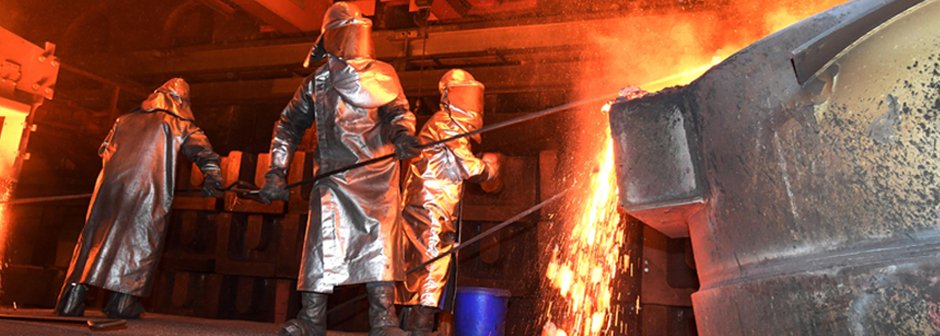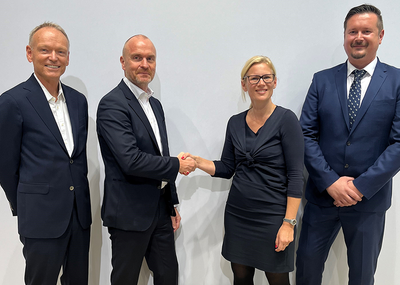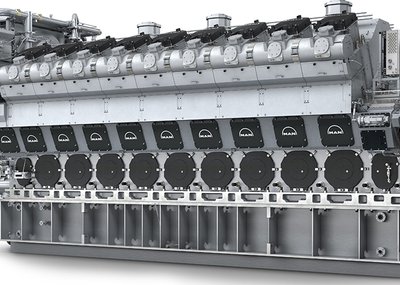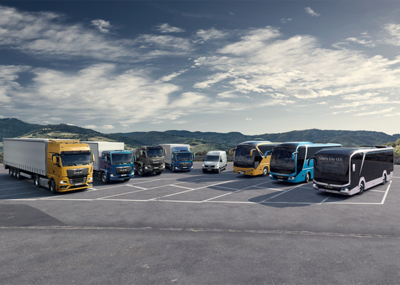A visit to the men on the spot with Dr. Michael Kerler, Augsburger Allgemeine, Business Department
Early in the morning hot iron at 1500 degrees flows out of the furnace. It is 5 o'clock. In In the last few hours, the workers at at MAN Energy Solutions have been melting scrap and pig iron. Now they are ready for the next step step, tapping the molten iron into high ladles, steel crucibles - lined with refractories to withstand the temperatures. Tonight, MAN Energy Solutions is preparing to cast the housing of an engine which, when fully assembled, will weigh 294 tons and tonnes and will propel ships across the world's oceans. The first step is to pour the iron from the from the furnaces into the ladles. These are later transported to another hall. Only there does the the casting take place.
The company MAN Energy Solutions in Augsburg is a manufacturer of large engines and operates the only large foundry in southern Germany, one of the oldest plants on the factory premises. The plant went into 1844 and was initially used for the production of components for Sander'schen Maschinenfabrik, which became Maschinenfabrik Augsburg in 1857 Augsburg and in 1908 to MAN. Today it is one of the five largest foundries for large parts in Europe. MAN Energy Solutions primarily produces housings of power plant and ship engines. The foundry also wants to win more orders from other companies and execute them with with high precision. Foundry manager Marco Nagler, 47, started his apprenticeship in Augsburg as a foundry mechanic. Then he studied foundrytechnology in Duisburgand worked in several functionsin other companies. In 2018, after around 20 years, he came back to Augsburg.
"Casting of iron is a complicated process," he says. "It consists of several steps that must not go wrong." The chemical composition of the molten metal, the temperature of the molten iron, the mould into which is poured. The PC can be used to simulate how the iron enters the mould and cools down. Around 50 to 60 large castings weighing up to 100 tonnes are produced a year. The housings are several metres long. Today the the team is casting a cylinder crankcase for a twelve-cylinder engine. This requires 76 tonnes of molten iron. The finished engine will be used in a ship.It is a so-called dual-fuel engine for natural gas and liquid fuels. Suddenly there is movement at the furnaces, that melt the iron. A gripper pulls the lid off the melting furnaces, The men remove the lids men remove the slag from on the surface of the molten metal. Bright light, orange, almost yellow, fills the room. Slowly the furnaces are tilted, then the iron flows smoothly into the two high pans. Two men climb ladders, clad in silver protective suits against the heat. They are less than two metres from the molten metal. A shower of sparks envelops the men, a heavy metal smell in the air. It is good for visitors to keep their distance. The ladles filled with molten iron are now ready for casting. vehicles will take them to the next hall.
New business concept - target 40% external orders to secure the location
In addition to parts for its own MAN Energy Solutions produces also housings for large gearboxes such as those used in mines. Important parts for hydroelectric or wind power plants reports Stephan Briehl, 50, who is responsible for sales to external customers. So far, around ten per cent of the orders for the foundry have come from outside, he says. The goal is to increase this to 30 to 40 per cent. The business with large engines fluctuates with the state of the world economy. With their new business concept, the team wants to secure the future of the foundry site with its jobs. The market opportunities are good: "Some large foundries disappeared from the market”, Briehl reports. The goal is to is to secure market share. The order situation with external customers is currently very positive. "After years of years of stagnation, things are finally up again.
" The foundry of MAN Energy Solutions employs currently 235 employees, who work in areas such as the pattern shop, the melting shop or the small, medium and large foundry. The drivers have meanwhile brought the ladles of molten iron into the hall. The molten iron is to be poured into the mould. The hot metal glows, its glow illuminating the ceiling of the hall, which is otherwise lost in darkness. A cathedral of industrialization. The hall is an old one the brown dust and soot has settled on the brick. Filter systems clean the air the air much better and faster than in than in earlier years. "After the ovens have been tapped time runs out," explains foundry manager Marco Nagler. The metal cools slowly outside outside the furnace, the team has to catch the exact moment when it has reached 1350 degrees. Then it runs optimally into the mould. The experts remove the slag from the from the molten iron. Sparks fly. Again, and again the team checks the temperature. The casting mould is deep under their feet. It was made the week before from sand which a resin makes as solid as sand as sandstone. It is an unwritten law that the team accompanies the production from start to finish. From the construction of the mould in sand to the 120-second casting.
From 2022 MAN will be working purely with green electricity
It is no coincidence that the moulds are cast at night. Electricity is not only cheapest at night, but is also available. The foundry needs as much electricity as several thousand households. "From 2022 onwards with green electricity," says Nagler. This is the foundry's contribution to climate protection. It takes time for the molten iron slowly cools down to the ideal temperature. Time for a chat. Vitus Fischer, 60, has been working years in the foundry. He has cast thousands of engines, and in 20 months he plans to retire. He says there is no hectic during the casting process. "Everyone knows what they have to do." The workers stand close to the molten metal. Fischer now holds the plate that prevents the slag from running into the mould. It is hot hot there.
"The protective suit can you can't touch it with your bear with your bare hands," says Fischer. The work is not not dangerous. "If you go about, it the right way nothing happens, you just must not be afraid." For 45 years he has worked in any other company. "I have always been here; the fascination hasn't let me go." Every year, the foundry trains apprentices, and there are currently nine. Employees who once start here often stay for a long time. Suddenly there is movement. The molten iron has reached the temperature of 1350 degrees, the employees take up their posts.
Everything runs quietly, almost silently, highly concentrated, routinised, practised in countless production rehearsed. Crane giants on the ceiling of the hall lift the cast iron ladles with steel cables and hooks, the men behind the protective suits step on wheels the large vessels can be easily lowered. As if from a gravy boat the iron flows into a basin, then into the mould deep in the floor. Weights above, weighing 700 tonnes counteract the strong forces underground. Pouring gases, which penetrate to the top, catch fire. It looks as if the ground is on fire. 17 days later the team will excavate the sand away. The casing will still be 350 degrees hot. After the sandblasting process they will find out whether everything was ok. The workers are sure.
Collegial thanks to Dr Michael Kerler, Augsburger Allgemeine, for his report and Bernd-Ulrich Wagner, Augsburger Allgemeine, for the impressive photos.








